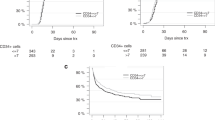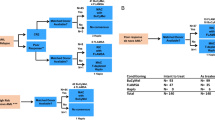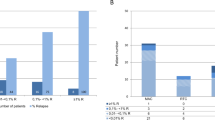Abstract
The detection of chimerism, residual molecular and cytogenetic disease following transplantation of peripheral blood stem cells (PBSCT) with a nonmyeloablative conditioning (n = 9) and the transplantation of highly purified CD34+ stem cells (CD34+ PBSCT) (n = 16) were compared to unmanipulated bone marrow transplantation (BMT) (n = 69) and unmanipulated PBSCT (n = 50) after myeloablative conditioning in patients with first chronic phase of chronic myelogenous leukemia (CML) (n = 137), second chronic phase of CML (n = 4), acute lymphoblastic leukemia (n = 2) and acute myeloid leukemia (n = 1). A molecular relapse (MR) as defined by two consecutive positive polymerase chain reaction assays for the detection of M-bcr-abl transcripts (n = 141) and cbfβ-myh11 transcripts (n = 1) in a 4-week interval was found in 10 of 16 patients (63%) after CD34+ PBSCT, and in 27 of 69 patients (39%) after BMT, whereas only three of 50 patients (6%) after PBSCT (P < 0.001) and one of eight patients (13%) after PBSCT with reduced conditioning suffered from a MR. A cytogenetic relapse occurred in five of 16 patients (31%) after CD34+PBSCT and 21 of 69 patients (30%) after BMT (NS) compared to two of 50 patients (4%) after PBSCT and none of the eight patients after PBSCT with reduced conditioning (P < 0.05). The lowest treatment-related mortality was seen in the 16 patients after CD34+ PBSCT, who are all currently alive with a median follow-up of 15 months, whereas the survival rate for BMT, PBSCT and PBSCT with reduced conditioning were 65%, 63% and 58%, respectively. Multivariate analysis including all potential influential factors of post-transplant residual disease recurrence showed that patients after CD34+ PBSCT had a significantly higher risk (two times) to develop a MR than patients after BMT (P < 0.03), whereas patients after unmanipulated PBSCT had a significant lower risk (eight times) for the occurrence of a MR post transplant (P < 0.001). Patients after BMT and CD34+ PBSCT had the lowest rates of complete chimerism (CC) at 3 months after transplant. Only five of nine patients (55%) after CD34+ PBSCT and 19 of 33 patients (58%) after BMT achieved CC compared to 19 of 22 (86%) patients after PBSCT and seven of eight (88%) patients after PBSCT with reduced conditioning (P < 0.05). Bone Marrow Transplantation (2001) 27, 809–815.
This is a preview of subscription content, access via your institution
Access options
Subscribe to this journal
Receive 12 print issues and online access
$259.00 per year
only $21.58 per issue
Buy this article
- Purchase on Springer Link
- Instant access to full article PDF
Prices may be subject to local taxes which are calculated during checkout



Similar content being viewed by others
References
Slavin S, Nagler A, Naparstek E et al. Nonmyeloablative stem cell transplantation and cell therapy as an alternative to conventional bone marrow transplantation with lethal cytoreduction for the treatment of malignant and nonmalignant hematologic diseases Blood 1998 91: 756–763
Goldman JM, Gale RP, Horowitz MM et al. Bone marrow transplantation for chronic myelogenous leukemia in chronic phase: increased risk for relapse associated with T-cell depletion Ann Intern Med 1988 108: 806–814
Roth MS, Antin JH, Ash R et al. Prognostic significance of Philadelphia chromosome-positive cells detected by the polymerase chain reaction after allogeneic bone marrow transplant for chronic myelogenous leukemia Blood 1992 79: 276–282
Radich JP, Gehly G, Gooley T et al. Polymerase chain reaction detection of the BCR/ABL fusion transcript after allogeneic marrow transplantation for chronic myeloid leukemia: results and implications in 346 patients Blood 1995 85: 2632–2638
Elmaagacli AH, Beelen DW, Opalka B et al. The risk of residual molecular and cytogenetic disease in patients with Philadelphia-chromosome positive first chronic phase chronic myelogenous leukemia is reduced after transplantation of allogeneic peripheral blood stem cells compared with bone marrow Blood 1999 94: 384–389
Elmaagacli AH, Beelen DW, Becks HW et al. Molecular studies of chimerism and minimal residual disease after allogeneic peripheral blood progenitor cell or bone marrow transplantation Bone Marrow Transplant 1996 18: 397–403
Beelen DW, Quabeck K, Kaiser B et al. Six weeks of continuous intravenous cyclosporine and short-course methotrexate as prophylaxis for acute graft-versus-host disease after allogeneic bone marrow transplantation Transplantation 1990 50: 421–427
Beelen DW, Ottinger HD, Elmaagacli A et al. Transplantation of filgrastim-mobilized peripheral blood stem cells from HLA-identical sibling or alternative family donors in patients with hematologic malignancies: a prospective comparison on clinical outcome, immune reconstitution and hematopoietic chimerism Blood 1997 90: 4725–4735
Glucksberg H, Storb R, Fefer A et al. Clinical manifestations of graft-versus-host-disease in human recipients of marrow from HLA-matched sibling donors Transplantation 1974 18: 295–304
Thomas ED, Storb R, Clift RA et al. Bone marrow transplantation New Engl J Med 1975 292: 895–902
Cox DR . Regression models and life tables J R Stat Soc 1972 34: 187–189
Kaplan EL, Meier P . Non-parametric estimation from incomplete observations J Am Stat Assoc 1958 53: 457–481
Elmaagacli AH, Beelen DW, Kroll M et al. Detection of CBFB/MYH11 fusion transcripts in patients with inv(16) acute myeloid leukemia after allogeneic bone marrow or peripheral blood progenitor cell transplantation Bone Marrow Transplant 1998 21: 159–166
Elmaagacli AH, Beelen DW, Schaefer UW . A retrospective single centre study of the outcome of five different therapy approaches in 48 patients with relapse of chronic myelogenous leukemia after allogeneic bone marrow transplantation Bone Marrow Transplant 1997 20: 1045–1055
Mackinnon S, Barnett L, Heller G, O'Reilly RJ . Minimal residual disease is more common in patients who have mixed T-cell chimerism after bone marrow transplantation for chronic myelogenous leukemia Blood 1994 83: 3409–3416
Barett JA, Ringden O, Zhang MJ et al. Effect of nucleated marrow cell dose on relapse and survival in identical twin bone marrow transplants for leukemia Blood 2000 95: 3323–3327
Wiesneth M, Schreiner T, Bunjes D et al. Comparison of T-cell depleted BMT and PBSCT with respect of chimerism, graft rejection and leukemic relapse J Hematother 1999 8: 269–274
Cornelissen JJ, Fibbe WE, Schattenberg AV et al. A retrospective Dutch study comparing T cell-depleted allogeneic blood stem cell transplantation vs T cell-depleted allogeneic bone marrow transplantation Bone Marrow Transplant 1998 21: (Suppl. 3) 66–70
Childs R, Clave E, Contentin N et al. Engraftment kinetics after nonmyeloablative allogeneic peripheral blood stem cell transplantation: full donor T-cell chimerism precedes alloimmune responses Blood 1999 94: 3234–3241
Bertheas MF, Lafage M, Levy P et al. Influence of mixed chimerism on the results of allogeneic bone marrow transplantation for leukemia Blood 1991 78: 3103–3106
Mackinnon S, Barnett L, Bourhis JH et al. Myeloid and lymphoid chimerism after T-cell depleted bone marrow transplantation: evaluation of conditioning regimens using the polymerase chain reaction to amplify human minisatellite regions of genomic DNA Blood 1992 80: 3235–3241
Weiden PL, Flournoy N, Thomas ED et al. Antileukemic effect of graft-versus-host disease in recipients of allogeneic marrow grafts New Engl J Med 1979 300: 1068–1073
Nakao S, Zeng W, Yamazaki H et al. Early establishment of hematopoietic chimerism following allogeneic peripheral blood stem cell transplantation in comparison with allogeneic bone marrow transplantation Eur J Haematol 1999 62: 265–270
Lawler M, Humphries P, McCann SR . Evaluation of mixed chimerism by in vitro amplification of dinucleotide repeat sequences using the polymerase chain reaction Blood 1991 77: 2504–2514
Acknowledgements
We thank Katja Ahrens, Melanie Kroll, and Ines Riepenhof for their excellent technical performance of the PCR analyses. This work was supported by a grant ‘Aktion Kampf dem Krebs’ of the German Cancer Society and a grant from ‘Deutsche Krebshilfe’ (Project-No. 70-1669-EL1).
Author information
Authors and Affiliations
Rights and permissions
About this article
Cite this article
Elmaagacli, A., Runkel, K., Steckel, N. et al. A comparison of chimerism and minimal residual disease between four different allogeneic transplantation methods in patients with chronic myelogenous leukemia in first chronic phase. Bone Marrow Transplant 27, 809–815 (2001). https://doi.org/10.1038/sj.bmt.1703000
Received:
Accepted:
Published:
Issue Date:
DOI: https://doi.org/10.1038/sj.bmt.1703000
Keywords
This article is cited by
-
Application of latent class analysis in diagnosis of graft-versus-host disease by serum markers after allogeneic haematopoietic stem cell transplantation
Scientific Reports (2020)
-
Outcome of allogeneic stem cell transplantation in patients with myelofibrosis
Bone Marrow Transplantation (2004)
-
Outcome of hematopoietic stem cell transplantation in patients with atypical chronic myeloid leukemia
Bone Marrow Transplantation (2004)



